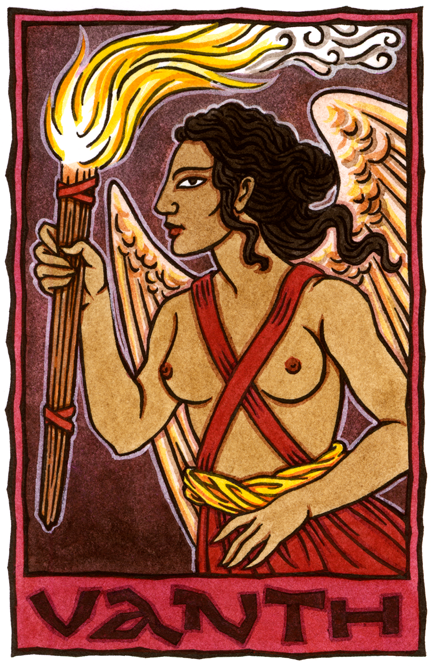 There now. It is time.
Vanth is an Etruscan Goddess of the Underworld, perhaps a psychopomp, whose presence indicates recent or impending death. Her character is a little ambigious—for while She is present at these scenes She does not usually take an active role, and thus some authorities call Her an "angel", others a "demon" (which is, ultimately, neither here nor there as those designations are outside of the original religion). Aside from the occasional statue or other independent representation, Vanth is nearly always depicted in scenes with an Underworld or death-theme—funerary monuments are an especially popular setting for Her—and Her part appears to be mostly one of observation. Quite a few Etruscan Goddesses were intermittently shown with wings, but with Vanth they seem to be an integral part of Her character: She is almost always shown with great arching wings that spread out behind Her and which have probably contributed to the appellation of "angel". Sometimes Her wings are painted with eyes, perhaps to represent all-seeing and inevitable death. With many of the other Goddesses (and the rare male Deity or exalted human such as Chalcas the Seer, a haruspex depicted on a mirror-back) the wings seem to be a simple indication of divinity (or in the case of mortals divine inspiration) as they are not always present; with Vanth, the fact that She is nearly always winged seems to point to Her great importance among the Gods, or perhaps indicates that She is a more purely Etruscan idea of Divinity, who unlike many other Etrsucan Goddesses, had no real Greek equivalent. A similar situation occurs with Lasa, a fate Goddess who was not strongly equated with any Greek Goddess; like Vanth, Her wings are an important and especial part of Her attributes. Another part of Vanth's particular iconography is Her outfit: peculiarly Her own, it consists of a short gathered or pleated skirt that is doubly belted (once underneath and then again over the folded-down part), short hunting boots, and nothing above the waist save a band or baldric that crosses between Her breasts. This outfit gives Vanth a distinctive active appearance, much like Artemis in Her short chiton that She wore for ease in running. Vanth sometimes carries a sword, though She rarely uses it; more often She carries a torch with which to light the dark Underworld. She can also be shown with a key with which to open the tomb or gate to the Underworld; and/or with snakes twined around both forearms, their heads in Her hands. She is quite frequently depicted as a partner to Charun, the Etruscan version of the Greek Charon, the Underworld guardian whose job it was to ferry souls over the River Styx. One favorite way of pairing them was to paint one on each side of the door of a tomb as if guarding the entrance. She has been called the "servant" of Charon; however, of all the Etruscan death or Underworld Deities (including Charun) Vanth has the most representations in Etruscan art, which leads me, anyway, to conclude that they were at least equals, and that more probably Vanth was Charun's boss. Despite Vanth's presence in some gruesome scenes—of battles or prisoner sacrifices—She seems to have had a distant, if not benevolent, role in things: though a harbinger of death, She does not appear to cause it. Her torch points to a possible role as a psychopomp, a God or other being who guides or escorts the newly-dead on the dark paths to the Underworld; perhaps, then She calmy waits near battles or other scenes of death so that She may fulfill this function. She does appear, at least in one depiction, to have some influence in saving someone from death: on the pediment of the temple at Tlamu (Latin Telamon, modern Talamone), She is shown riding in a chariot with Adrastus, the only Hero of the Seven Against Thebes who made it home alive. Though the sculpture itself is fragmentary, Vanth is shown in Her unmistakable outfit of crossed baldrics between bare breasts, with Her wings outstretched behind Her. She has Her arms about Adrastus protectively as he makes his escape. Vanth seems to have appeared among the Etruscans in the 4th century BCE, as Her earliest depictions only trace that far back, but She does not appear to have been imported from the Greeks, though She has been loosely linked to the Greek idea of the Erinyes (called in Rome the Furies), who were winged Goddesses of Vengeance. Once on the scene however She proved quite popular; and Her worship made it as far as Campania, where a bronze statuette of Her from 425-400BCE was found not far from Mt Vesuvius. Remembrance of Vanth may have persisted even into Roman times: in the Villa of the Mysteries at Pompeii is a famous fresco of the 1st century CE depicting some sort of Dionysian initiation ritual. One of the participants is a winged woman with a switch; she wears boots and a short skirt and has been identified as Vanth. Though the significance and exact order of this initiation scene is still a matter of debate, the presence of Vanth or a Vanth-like figure may relate to Her old function as a Death-Goddess or Psychopomp: for initiation is symbolically seen as dying to one's old way of life to be reborn into the new. Like the Lasae, the Vanths are sometimes spoken of in the plural, and make up a loose band of Underworld Goddesses or Spirits. Also called: Van This design is available on prints through ArtPal. |